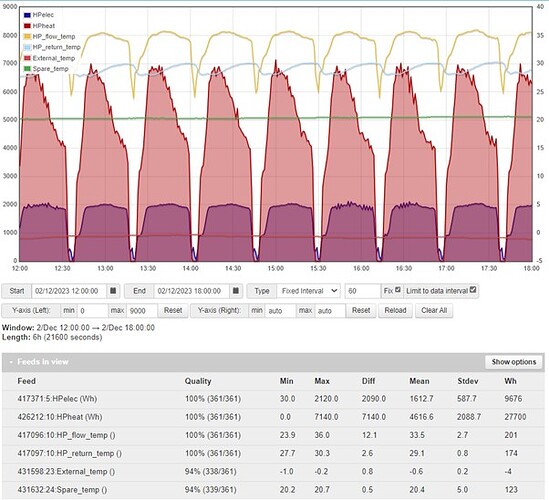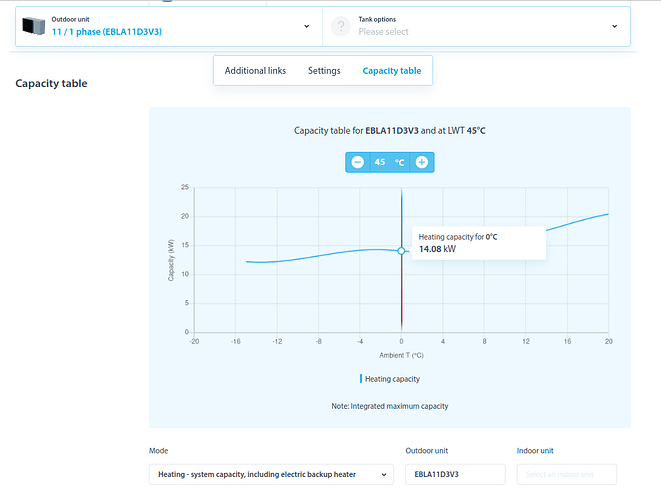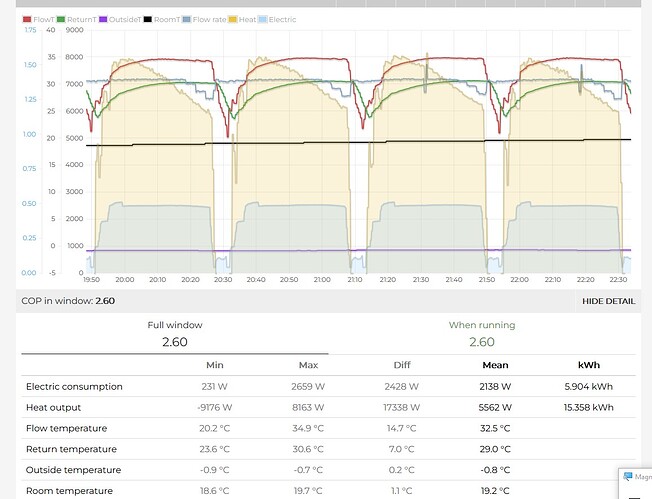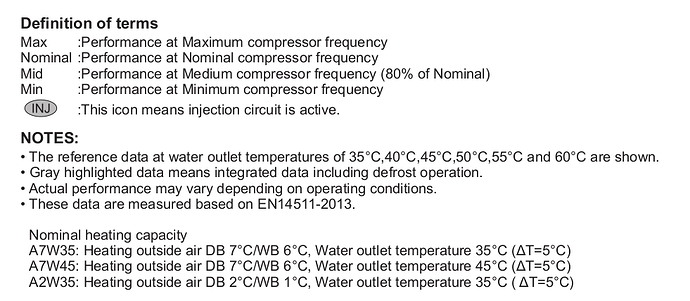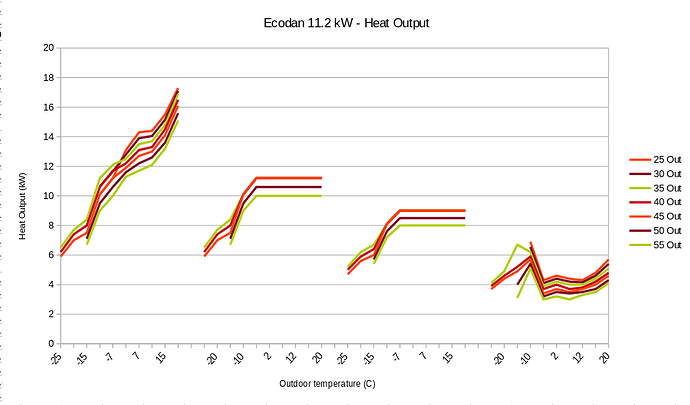@TrystanLea Trystan - here’s the data for my NIBE F2040-8 (R410a) heat pump for a 6 hour period on Saturday when external conditions were between 0 and -1°C and freezing fog meaning relative humidity would be close to 100% (external sensor was reading around 98% but RH sensors are not very accurate at such extremes of the range). The evaporator frosts up very quickly on my NIBE under these conditions, with cycle lengths around 40 mins with a 2 minute defrost and 3 minute waiting period till the next cycle start. Flow temperature is nominally 35°C with peak heat output around 7kW falling to around 4kW at the end of the cycle due to the effect of the frost build up. COP is around 3.5 at start of cycle falling to around 2 at the end (average for 6h hours including impact of defrosts = 2.9). Input power was being software limited by the NIBE adaptive controls to an inverter frequency of 81Hz giving about 2kW power input (The NIBE F2040 8kW model will actually go up to 120Hz/3.5kW electric input so there is still plenty of capacity left). My house HTC is around 200 W/K measured - so with average inside-outside delta-T of 21K over the period it would need something like 4.2kW to maintain temperature (ignoring the effect of gains). Actual mean heat output over 6 hours was 4.6kW, hence why internal temperature was rising for the period. NIBE published performance curves for F2040-8 show “Max specified” heat output of 6kW at -1°C external/35°C flow temperature and nominal COP around 3.2 for same conditions - though it doesn’t state the RH assumption for the data.
Jez
A note of interest for those with Daikin heat pumps, Daikin have an interactive databook tool here https://daikintechnicaldatahub.eu/en-GB/altherma-3-m/combination/
It gives outputs with and without the backup heater. The following example is with the backup heater:
Without backup heater:
- 11.08 kW at 0C
- 10.94 kW at 2C
Our results:
- 8.7 kW over 4 cycles including defrosts (1.32C outside)
- 7.8 kW on the last cycle at 0.6C outside
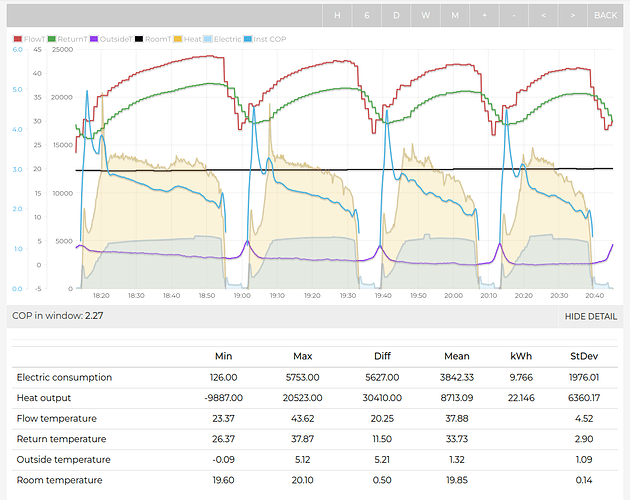
Im in contact with Daikin technical support that gave the above link. No light yet on why we’re seeing this difference in output. I will keep this thread updated with any developments. I’m definitely open to the possibility that we have missed something and that greater outputs are possible.
This clarifies at least that we should expect the ~11kW of output without the backup heater and COP’s should be around 2.44 (2C outside)
Thanks Trystan, it will be interesting to see what Daikin say. I had a letter a few days ago from the receivers of UK heat pumps in Basingstoke who installed my Daikin, they had me listed as a creditor for the value of my installation. Curiously, as I’m not a creditor as the installation was completed. They must have suffered a lot as they told me last year that dealing with Daikin was a nightmare. Legally they were caught in the crossfire between unhappy customers and an unresponsive Daikin. Next year I have to find a decent Daikin servicing engineer…in the Aldershot/Farnham/Basingstoke area. …if anyone knows one please let me know.
Wow, that’s interesting. I still haven’t heard back from my email to Daikin support - did you email/call/use a proxy?? Meanwhile, I’ll look at my EDLA09’s data with interest. It’s also an excellent source for all the manuals etc. on the other tabs on that link.
I emailed ![]() I sent my email on the 7th of December.
I sent my email on the 7th of December.
Maybe you are confusing maximum output with mean output. I would expect the manufacturers data to give maximum output, but mean output in a defrost situation is going to be a lot less.
Hers’s a random sample from my Samsung 8kW.
The mean output is 5.5kW but the maximum is 8.2kW which is slightly more than the specified output under those conditions.
Guesstimating from your graph it looks like the peak output is over 12kW. Apart from the defrosts, the potential output reduces as the frost reduces the airflow over the heat exchanger.
On the face of it it looks reasonable to me.
Thanks @billt
Im assuming that defrosts are included and that the capacity data should be mean output. Im pretty sure it should include defrosts…? We have had indication from another manufacturer that their data does not though… so you never know! Wish this was all a bit more explicit in the databooks!
It’s not particularly clear in the EN 14825 standard, the only references to defrosts are:
…
and later…
I have to say that the literature and test standards are highly ambiguous on what you would think is the most important design number for correct sizing of an installation. The MCS heat pump guide for example;
Heat-Pump-Guide.pdf (mcscertified.com)
Says on page 16;
3.4. Heat Pump Capacity
It is essential that a heat pump is selected to achieve the desired output for at least the design
conditions, if not slightly more onerous conditions which may not be the same as the nominal rating
of the unit. Lack of understanding of the variation in the performance of heat pumps at different
operating conditions has been identified as causing significant under-sizing in previous field trial reports.
For instance, the standard rating condition for ASHPs used to be air at 7oC and water flow at 35oC. However, in practice they may be required to produce water at approximately 55oC with
design ambient temperatures of circa -2oC. At these latter conditions **the output of many heat **
> pumps could be as little as 60% of the output at ‘standard’ (nominal) rating. For example a 13kW
ASHP may provide 13kW of heat at 7oC and 35oC flow temperature but it is unlikely to do this at an air temperature of -2oC and water flow at 55oC.
The actual output could be as little as 7-9kW and hence, if relied upon for the design of the system,
it will be vastly under-sized incurring the cost of expensive supplementary heating and/or lead to
issues of poor comfort.
This implies a massive output drop during defrost and yet there is no data that I have seen from any manufacturer that shows this drop. Try and spot the defrost affect below +4c on this Daikin graph for example.
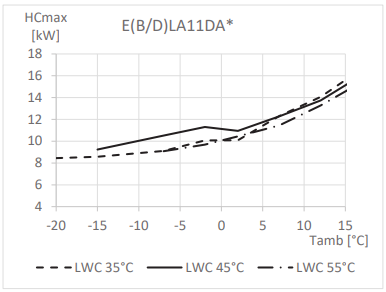
As @TrystanLea has said the EN standard, on which MCS relies does suggest that defrosts are taken into account when stating the maximum capacities.
So on a key design point there is either something critically important that is completely missing in the manufacturers data (capacity with defrosts) AND/OR the test standard for capacity bears no relation to any realistic use in areas where the temps drop below 4c.
It makes me wonder whether something along the lines of the VW diesel emissions test defeat mechanism is at play here… but surely, that cannot be true as MCS would have picked up on it ?
Its like saying that the top speed of my car is 250mph … in a vacuum !
I agree Colin.
There is a distinct lack of data and clarity about the most important aspects of how these heat pumps perform, stuff we need to know when making informed purchasing decisions.
Generally, it’s too late finding out what you wished you had known before buying once the thing has been installed and you come to use it in anger months later.
It’s all quite disappointing in many respects and it feels like the important stuff is hidden or not disclosed on purpose.
I would think that it’s relative easy to measure performance at known flow and air temperatures with non condensing humidity. Adding condensing humidity will add more variables to increase the confusion. What humidity level do you choose and a t what air temperature?
Curiously swimming pool heat pumps seem to quote humidity levels in their specs. For instance my cheapish swimming pool heat pump quotes an output of 28kW at air 27C/water 27C/ humidity 80% and 19kW at air 15C/water 26C/humidity 70%. Their’s still not enough information to predict the real world performance though; the figures are just a snapshot in a world where the real conditions are continually varying.
Unfortunately I don’t think that you’ll get a single figure of merit for heat pumps. The output varies with too many input variables. It’s easy with a fossil fuel boiler, the name plate output is pretty much what you will get. Very much not so with heat pumps.
It’s not easy of course but if we take the Ecodan databook as an example, it gives the following table for the 14 kW unit. While this databook does not supply a dry bulb / wet bulb temperature. There’s often a 1K difference given on other examples, suggesting around 80-87% RH.
Wet-bulb / dry-bulb difference example:
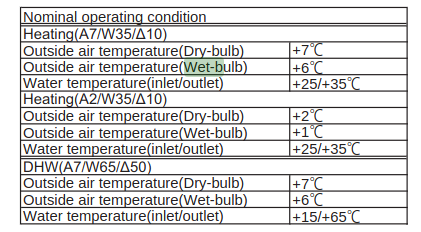
So we just need to know the period over which these tests are conducted during defrost conditions e.g how many cycles are being averaged over and whether defrosts are indeed included as they should.
Given the work undertaken to produce these databooks it doesn’t seem to be too much to ask to have this additional info spelled out?
If you have decided that the house heat loss at say -2c needs to be measured as accurately as possible (because that represents the 99% ish operating limit for most of England and Wales) then surely the test capacity standard you need is ‘mean output at 100% RH (freezing fog) and -2c’ so that you can accurately size the heat pump to match.
If this isn’t available then you just cannot compare manufacturer A’s 7kw model with Manufacturer B’s 7kw model because one of them might have a larger evaporator and so longer time-between-defrost and so higher defrost tolerance and higher real world output.
The whole point of weights and measures / NPL/ Test standards is to enable apples-to-apples comparisons. Are we seeing that heat pumps are exempt from this? If so the politicians can expect a lot more bad press against the governments heat pump push for the silly reason that the MCS standards are as good as useless in the real world?
I can feel a letter to my MP coming on…
It would be interesting to chat to someone from MCS about this.
I looked at this table again and was puzzling over the meaning of ‘nominal’ and how it might differ from ‘Max’. The dictionary definition of nominal is ‘existing in name only’. So, er, a 14 kw model does 14kw nominal… am I being thick here? Surely it must mean something else otherwise what is the point?
Hi Colin,
I think it is a branding thing.
Isn’t the 11kW actually 10.6kW ?
They are never going to call it a 13.83kw or a 14.26kW, whatever its actual output might be.
I take nominal to mean in name only, an approximation.
We sell timber, a 4 x 2 is a nominal size of 47mm x 100mm and an actual size of 45mm x 95mm minus a bit for green measure, that is it shrinks as it dries.
There was a time when the profit on some timber was derived entirely from shipping at the actual size, minus 3mm and selling at the nominal size.
It is fictional, not reality, existing in name only.
As far as our Daikin heat pumps are concerned, I see no point in selling or buying anything other than the 16kw, nobody gains anything from the `smaller’ ones.
Well actually they do, Daikin gain!
I can’t see it as anything other than marketing deception.
My situation would be no worse with the 16kW version, I would never even know if somebody swapped it in the middle of the night.
And you would be better off with the 16kw when you needed it with absolutely no downside other than the price.
The databook tries and fails to explain some terms they use:
Here’s visualisation of a similar table for the 11.2 kW R32 unit by same manufacturer. Output at Max, Nominal, Mid and Min levels, over a range of outdoor temperatures and flow temperatures:
Note how Nominal output is very close to badge power.
I guess nominal is stating the COPs at the badge ratings except when the tempdrops and the unit cannot make those badge numbers then it’s something else ( but not the max according to the Ecodan table that Trystan has posted above).
Bottom line is that huge volumes of data is presented but, without apparent reference to the defrost impact, it seems to be mostly of no use in sizing any system … unless you live somewhere where the design temp is above 3c.
I wonder if this derives from the cooling usage of heat pumps?.. or heating pools?
It’s no surprise that the vendor literature is awful. It’s marketing copy for the most part rather than technical design material to suit a buying market that isn’t well informed.
The UK hasn’t really done any of it’s own homework on this from a standards perspective either.
(MCS are just rehashing the European test data slightly to excuse there being a purpose in using their sCOP figures)
And at the more continentally relevant -7C test point nobody really gives two hoots about the capacity loss whilst it’s still relatively warm out.
Probably helpful to require a real noise test, transmitted vibration test (pipes and feet) of some flavour, and a real capacity test at the usual UK design condition (-2 and 100% RH?) of sufficient duration to prevent any gamesmanship on defrosting.
It’s possibly quite a hard test to make repeatable though. I should imagine that providing such a climate isn’t easy!
Or it’s -10C and anything that can do “25” units of heat at -10C can easily do “15” units of heat at 0C even with the most worthless defrosting programme so “meh” at bothering to test part load capacity.
